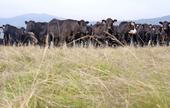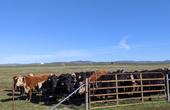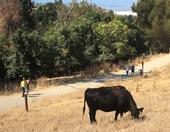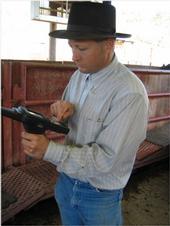- Author: Emily C. Dooley, UC Davis

Matching herds to landscape can support animal growth and ecological needs
Not all cattle are the same when it comes to grazing. Some like to wander while others prefer to stay close to water and rest areas.
Recognizing those personality differences could help ranchers select herds that best meet grazing needs on rangelands, leading to better animal health and environmental conditions, according to a new paper from the University of California, Davis, published in the journal Applied Animal Behaviour Science.
“Cattle can actually be...
- Author: Pamela Kan-Rice

University of California Cooperative Extension and UC Davis Veterinary Medicine are sharing recordings of their March 2022 cattle health webinar series for California cattle ranchers. This series was co-hosted by UC Cooperative Extension advisors Tracy Schohr, Grace Woodmansee and Rebecca Ozeran and UC Cooperative Extension specialist Gabriele Maier.
“Last month hundreds of cattle producers joined us for evening webinars that took a deep dive into a cross section of important cattle health topics,” said co-host Schohr, UC...
- Author: Mike Hsu

The pandemic has brought more people into nearby parks and public lands for hiking, biking and other recreational activities. In areas like the East Bay Regional Parks – a San Francisco Bay Area park system totaling more than 120,000 acres where about 65% of the land is grazed by livestock – visitors might see goats, sheep and, most likely, cattle.
Those encounters with animals (or their manure) represent a prime opportunity for members of the public to learn about agriculture and the ecological benefits of rangelands, according to Larry Forero, a UC Cooperative Extension livestock and natural resources advisor.
“In addition to supporting the raising...
- Author: Amy Quinton

UC Davis report suggests ways to build resilience
The University of California, Davis, Food Systems Lab has released a
- Author: Janet Byron

information into hand-held device.
By assigning a simple, 15-digit identification number to cows, UC researchers can track each one from conception to carcass, garnering valuable data for studies on cattle fertility, genetics, and health, and helping to select breeding animals with desirable beef characteristics such as flavor and tenderness.
In today’s beef market, an individual cow may change ownership many times during its lifetime as it travels from the ranch of its birth, to stocker and feedlot, to slaughterhouse, and finally supermarket or steakhouse. In the process, valuable data is lost along with the ability to “trace back” particular steaks to the original cow.
For several years, UC Davis researchers have been attaching a round, electronic ear...



